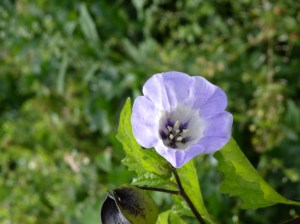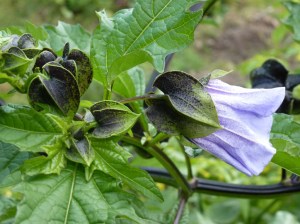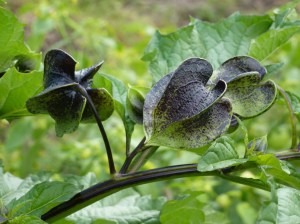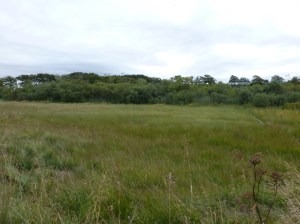Continuing the memories from the summer – with this second catch up from the 14 September 2013.
At the beginning of the previous blog I said I had been studying a couple of strange plants at the allotment, the second of these plants was hiding amongst the Celeriac. By the time I found this plant at the end of July it was about a foot tall and never really grew much taller than this. As with the Apple of Peru this plant had slightly lobed, diamond shaped leaves, but with out any purple colouring, above which were several cream trumpet shaped blooms. By the time I found this plant the central flower had already gone and a seed was forming at the top of the stem, a distinctively prickly seed that looked like it was going to form a bur of some sort. As for the identification – not so difficult this time as I’ve seen flowers like this before on greenhouse plants called Angel Trumpets, so I soon tied this plant down to Thorn Apple.
 Thorn Apple – 17 August 2013 (Copyright Carol Jones)
Thorn Apple – 17 August 2013 (Copyright Carol Jones)
I suspect that this is another plant that I shouldn’t have left in the allotment, especially as it was a poisonous plant amongst the edible crop of Celeriacs, but the delicate cream trumpets were very pretty and the bur covered seed pod in the centre of the plant was fascinating. This seed pod over the weeks from summer into autumn grew in size and by September had reached a size, that made the plant look like a matchstick man with the leaves forming the arms and the main stalk the legs, with the bur as the head. This plant also fascinated a number of the other allotment holders who also agreed with me that it looked like a matchstick man.
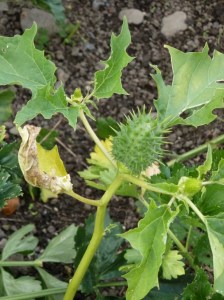 Ripening Seed Head – 13 September 2013 (Copyright Carol Jones)
Ripening Seed Head – 13 September 2013 (Copyright Carol Jones)
As the summer ends this seed pod has continued to grow and finally begun to brown and ripen. I know that before the plant had got to the stage of having ripe seeds, I should really have removed it and deposited it on the compost heap, especially as the RHS web site says that the seeds can live for a number of years in the soil. All I can say was that I was totally fascinated by its development, it was almost as if it was animal rather than plant. It felt like I was totally hypnotised! Well thank heaven its not a Trifid and I’ve a trusty hoe that will keep it’s progeny under control.
